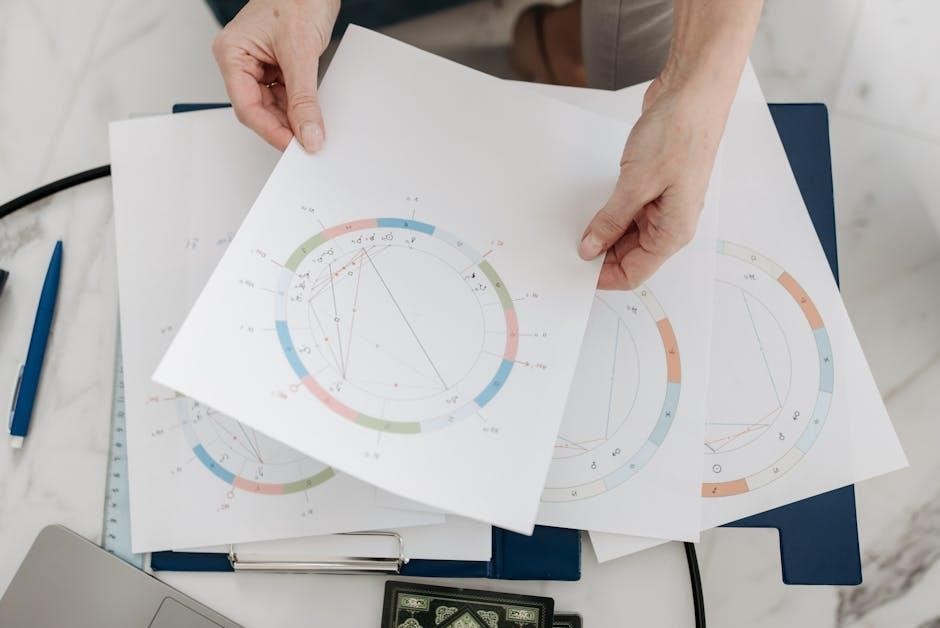Dream interpretation explores the hidden meanings behind dreams‚ offering insights into the subconscious mind. It involves analyzing symbols‚ emotions‚ and themes to uncover personal truths and emotional states.
Overview of Dream Interpretation
Dream interpretation is the process of assigning meaning to dreams‚ exploring their symbolism‚ and connecting them to the dreamer’s subconscious thoughts and emotions. It involves analyzing themes‚ emotions‚ and symbols to uncover hidden messages. Rooted in ancient practices‚ dream interpretation has evolved‚ blending psychological theories with modern techniques. Influenced by figures like Freud and Jung‚ it suggests that dreams reflect unconscious desires‚ unresolved conflicts‚ or future insights. By examining recurring motifs and personal associations‚ individuals can gain self-awareness and emotional clarity. Whether through journaling or professional analysis‚ interpreting dreams offers a gateway to understanding one’s inner world‚ fostering personal growth and emotional healing. This practice remains a fascinating blend of science‚ psychology‚ and mysticism.
History of Dream Analysis
Dream analysis traces back to ancient civilizations‚ where dreams were often seen as divine messages or omens. Early cultures believed dreams connected humans to the gods‚ guiding decisions and predicting futures. As societies evolved‚ so did interpretations‚ with psychological theories emerging in the late 19th century. Freud’s work laid the groundwork‚ suggesting dreams as windows to the unconscious mind‚ while Jung later introduced the concept of collective unconsciousness. Modern research uses brain imaging to study dream patterns‚ blending science with traditional symbolism. Today‚ dream analysis is a blend of ancient mysticism and psychological insight‚ offering deeper understanding of human consciousness and emotional processes. This rich history underscores the enduring fascination with deciphering the hidden language of dreams.
The Science Behind Dreams
Recent research utilizing advanced brain imaging technologies has shed light on the neurological processes behind dreaming. Studies indicate that dreams occur primarily during the REM sleep stage‚ when brain activity resembles wakefulness. Neuroscientists have identified specific brain regions‚ such as the visual cortex‚ that are active during dreaming‚ contributing to the vivid imagery often experienced. The brain synthesizes memories‚ emotions‚ and sensory inputs during REM sleep‚ creating the surreal narratives of dreams. This scientific understanding complements psychological theories‚ offering a biological basis for why dreams occur and how they relate to cognitive functions like memory consolidation and emotional regulation. By exploring the neural mechanisms‚ scientists aim to unlock the full potential of dream analysis for mental health and self-awareness.

Key Concepts in Dream Interpretation
Dream interpretation involves understanding symbols‚ emotions‚ and themes. It explores the subconscious mind‚ revealing hidden desires and unresolved conflicts‚ aiding self-awareness and emotional healing through analysis.
The Role of the Subconscious Mind
The subconscious mind plays a pivotal role in shaping dreams‚ as it processes thoughts‚ emotions‚ and experiences beyond conscious awareness. Through symbolism and metaphors‚ it communicates hidden desires‚ unresolved conflicts‚ and deep-seated fears. By analyzing these elements‚ individuals can gain insights into their inner world‚ fostering self-awareness and emotional healing. The subconscious mind acts as a bridge between the conscious and unconscious‚ revealing aspects of oneself that may otherwise remain unexplored. This process highlights the mind’s ability to reflect and resolve internal struggles‚ emphasizing the importance of dream interpretation in understanding personal psychology and emotional well-being.
Dream Symbols and Their Meanings
Dream symbols are representations of thoughts‚ emotions‚ and experiences‚ often encoded in metaphors or imagery. These symbols vary in meaning depending on personal associations and cultural contexts. For example‚ water may symbolize emotional depth or transformation‚ while falling could represent loss of control or fear. Common symbols like flying‚ being chased‚ or water appear frequently‚ each carrying unique interpretations. Modern research suggests that these symbols reflect unconscious desires‚ unresolved conflicts‚ or hidden fears. By decoding these symbols‚ individuals can uncover deeper insights into their psyche and emotional state. Dream interpretation guides‚ like the “interprétation des rêves de a à z pdf‚” provide frameworks for understanding these symbols‚ helping individuals navigate their subconscious mind and uncover hidden meanings.
The Difference Between Literal and Metaphorical Dreams
Dreams can be categorized into two main types: literal and metaphorical. Literal dreams reflect real-life events or straightforward desires‚ often mirroring experiences or thoughts from waking life. For example‚ dreaming about eating when hungry. Metaphorical dreams‚ however‚ use symbols and imagery to convey deeper meanings‚ requiring interpretation to uncover hidden emotions or unconscious thoughts. For instance‚ flying may symbolize a desire for freedom or empowerment. Understanding the distinction between these types is key to effective dream analysis. Literal dreams offer clarity‚ while metaphorical ones invite exploration of the subconscious. This differentiation helps dreamers decode their experiences‚ whether through personal reflection or guided resources like the “interprétation des rêves de a à z pdf‚” enhancing self-awareness and emotional understanding.

Popular Dream Symbols and Their Interpretations
Dreams often feature recurring symbols like falling‚ flying‚ water‚ and being chased. These symbols hold universal meanings‚ such as fear of loss‚ desire for freedom‚ emotional depth‚ or avoidance of challenges‚ offering insights into personal emotions and subconscious thoughts.
Dreams About Falling
Dreams about falling are among the most common and universal‚ often symbolizing a loss of control or feeling overwhelmed in waking life. They may reflect anxieties about failing‚ losing status‚ or struggling with personal or professional challenges. Falling can also signify a fear of the unknown or a sense of surrendering to circumstances. In some interpretations‚ falling represents a need to let go of something or someone‚ encouraging emotional release. The context of the dream‚ such as where you’re falling from or how you feel during the fall‚ can provide deeper insights. These dreams often prompt self-reflection‚ urging the dreamer to address underlying fears or insecurities. By exploring associations and emotions tied to the dream‚ individuals can uncover its personal significance and gain clarity.
Dreams About Flying
Dreams about flying often symbolize empowerment‚ freedom‚ and a sense of rising above challenges. They may indicate a desire for control‚ confidence‚ or a new perspective on life. Flying can represent personal achievements‚ overcoming obstacles‚ or a longing for spiritual or emotional elevation. The height and ease of flying in the dream can reveal the extent of one’s confidence or aspirations. If the flight is effortless‚ it suggests mastery over situations‚ while turbulence may signify unresolved fears or doubts. These dreams encourage self-reflection on goals and aspirations‚ offering insights into the dreamer’s inner state. By examining the emotions and context‚ individuals can unlock the deeper meaning behind this common and uplifting dream scenario‚ fostering personal growth and self-awareness.
Dreams About Being Chased
Dreams about being chased are among the most common and often reflect feelings of stress‚ anxiety‚ or a sense of being overwhelmed in waking life. They may symbolize unresolved issues‚ unaddressed fears‚ or a feeling of being pressured by external circumstances. The chaser in the dream can represent aspects of oneself‚ such as self-criticism or unmet expectations‚ or external sources like deadlines‚ relationships‚ or societal demands. The intensity of the chase and the emotions experienced during the dream can provide clues about the root cause of the distress. Interpreting these dreams involves reflecting on personal circumstances and identifying areas where the dreamer may feel pursued or out of control. By addressing these underlying concerns‚ individuals can gain insight and work toward emotional resolution and peace of mind.
Dreams About Water and Its Symbolism

Dreams about water are deeply symbolic‚ often representing emotions‚ the subconscious‚ and spiritual states. Calm water‚ such as a serene lake or peaceful ocean‚ may signify emotional balance‚ clarity‚ and inner peace. Conversely‚ turbulent water‚ like waves or floods‚ can indicate turmoil‚ overwhelming emotions‚ or unresolved conflicts. Dreams involving swimming may suggest navigating through challenges or exploring the subconscious. Drowning could symbolize feelings of being overwhelmed or losing control. The condition and context of the water in the dream are crucial for interpretation‚ as they reflect the dreamer’s emotional state and personal experiences. Water’s versatility in dreams makes it a powerful tool for understanding hidden feelings and spiritual growth.

Methods of Dream Interpretation
Dream interpretation involves techniques like Freudian psychoanalysis‚ Jungian psychology‚ and modern methods. These approaches explore symbols‚ emotions‚ and personal associations to uncover hidden meanings and subconscious truths.
Freudian Psychoanalysis and Dreams
Freudian psychoanalysis views dreams as the “royal road” to the unconscious mind‚ revealing repressed desires‚ conflicts‚ and unresolved childhood experiences. According to Freud‚ dreams are a way for the mind to communicate hidden truths through symbolism and metaphors. He believed that dreams have two layers: the manifest content‚ or the literal narrative‚ and the latent content‚ the underlying‚ unconscious meaning. Freud used techniques like free association to help patients uncover the latent meanings of their dreams‚ often linking them to unresolved past traumas or unexpressed wishes. This approach emphasizes the role of the unconscious in shaping dream imagery and highlights the therapeutic potential of dream analysis in understanding human psychology and behavior.
Jungian Analytical Psychology
Jungian analytical psychology emphasizes the role of dreams in the process of individuation‚ or the integration of the unconscious and conscious mind. Carl Jung believed that dreams reveal aspects of the collective unconscious‚ a shared reservoir of archetypes common to all humans. He introduced the concept of “amplification‚” where dreamers explore symbols through personal associations and cultural context to uncover deeper meanings. Jung also distinguished between the personal unconscious and the collective unconscious‚ with dreams often reflecting both. His approach encourages individuals to engage actively with their dreams‚ fostering self-awareness and psychological growth. By examining recurring themes and symbols‚ Jungian analysis aims to bridge the gap between the conscious and unconscious‚ promoting a balanced and whole psyche.
Modern Techniques for Interpreting Dreams
Modern techniques for interpreting dreams blend traditional methods with advanced tools and technology. Brain imaging has revealed insights into the neural activity during sleep‚ helping scientists understand the biological basis of dreaming. Digital apps and platforms now offer personalized dream analysis‚ utilizing AI to identify recurring symbols and themes. These tools often incorporate both personal associations and cultural contexts‚ providing a holistic view of dream meanings. Modern approaches also emphasize the role of the dreamer in decoding their own experiences‚ fostering a more interactive and self-reflective process. Techniques like “dream incubation” and “reality testing” are gaining popularity‚ allowing individuals to explore their subconscious mind actively. These methods highlight the evolving nature of dream interpretation‚ blending science with personal introspection to uncover deeper truths.

Practical Steps for Interpreting Your Dreams
Keep a dream journal‚ identify recurring themes‚ and use associations to decode symbols. Modern tools and AI apps can also aid in personalizing interpretations for deeper insights.
Keeping a Dream Journal
Keeping a dream journal is a powerful tool for capturing and analyzing your dreams. By documenting your dreams immediately upon waking‚ you preserve details that might otherwise fade. Consistency is key‚ as regular recording helps identify recurring themes and symbols‚ offering insights into your subconscious mind. Over time‚ patterns emerge‚ revealing hidden emotions‚ desires‚ and unresolved issues. This practice fosters self-awareness and personal growth‚ allowing you to better understand your inner world. Additionally‚ dream journals can aid in problem-solving and emotional healing by uncovering underlying thoughts and feelings. For those who struggle to remember their dreams‚ modern tools like mobile apps can assist in maintaining a consistent and organized record of your nocturnal experiences.
Identifying Recurring Themes in Dreams
Identifying recurring themes in dreams is a crucial step in understanding their hidden meanings. Dreams often reflect unresolved emotions‚ unconscious desires‚ or ongoing challenges in waking life. By tracking recurring symbols‚ such as falling‚ flying‚ or being chased‚ you can uncover patterns that reveal deeper psychological insights. These themes may symbolize personal growth‚ fear of failure‚ or a need for control. Over time‚ recognizing these motifs can help you address underlying issues and gain self-awareness. Modern techniques‚ like journaling or using dream analysis apps‚ make it easier to identify and interpret these recurring elements. This process not only enhances your understanding of your subconscious but also fosters emotional healing and problem-solving abilities. Paying attention to these themes can lead to profound personal insights and transformation.
Using Associations to Decode Symbols
Using associations to decode symbols is a powerful method in dream interpretation‚ emphasizing personal connections to elements in your dreams. This technique‚ rooted in Carl Jung’s analytical psychology‚ involves exploring your feelings‚ memories‚ and experiences linked to specific symbols. By asking non-leading questions‚ you guide the dreamer to uncover their own meanings‚ rather than relying on external interpretations. Modern approaches highlight the importance of self-discovery‚ encouraging individuals to reflect on their unique emotional and psychological landscapes. This method fosters a deeper understanding of subconscious thoughts and emotions‚ allowing for profound insights into personal growth and self-awareness. Regular practice‚ paired with tools like dream journals or professional guidance‚ can enhance your ability to decode symbols and unlock the hidden messages in your dreams.

Cultural and Religious Perspectives on Dreams

Cultures and religions worldwide have revered dreams as divine messages or spiritual guidance. Ancient civilizations‚ like Egyptians and Greeks‚ saw them as omens or communications from gods.
Dreams in Ancient Cultures
In ancient societies‚ dreams were often viewed as divine messages or omens. Egyptians believed gods communicated through dreams‚ influencing pharaohs’ decisions and religious practices. Similarly‚ Greeks sought dream guidance in temples dedicated to gods like Apollo and Asclepius. In ancient China‚ Confucianism emphasized the symbolic nature of dreams‚ linking them to moral lessons. Many cultures developed rituals to interpret and honor dreams‚ reflecting their deep spiritual significance. These beliefs laid the foundation for modern dream interpretation‚ blending psychology with timeless cultural wisdom.
Religious Views on Dreams and Their Significance
Religious traditions often regard dreams as sacred communications from the divine. In Christianity‚ the Bible includes prophetic dreams guiding figures like Joseph and Daniel. Islam similarly values dreams‚ with the Prophet Muhammad emphasizing their spiritual significance. Hinduism and Buddhism also recognize the importance of dreams‚ associating them with spiritual growth and hidden truths. Many religions believe that certain dreams carry divine messages‚ offering guidance or warnings. These beliefs highlight the enduring role of spirituality in shaping the interpretation and meaning of dreams across cultures and time.

The Psychological Benefits of Dream Interpretation
Dream interpretation enhances self-awareness by uncovering hidden emotions and unresolved conflicts. It fosters personal growth and emotional healing‚ providing insights into subconscious thoughts and desires.
Self-Awareness and Personal Growth
Dream interpretation is a powerful tool for enhancing self-awareness and fostering personal growth. By exploring the hidden meanings of dreams‚ individuals can gain insights into their subconscious thoughts‚ desires‚ and unresolved conflicts. This process helps in understanding one’s emotional landscape‚ identifying patterns‚ and recognizing areas for improvement. Dreams often reveal aspects of the self that are not immediately apparent in waking life‚ such as buried fears‚ unmet needs‚ or untapped potential. Through analyzing these symbols and themes‚ individuals can develop a deeper understanding of themselves‚ leading to greater emotional intelligence and introspection. This heightened self-awareness enables personal growth by encouraging individuals to confront challenges‚ embrace change‚ and cultivate a more authentic sense of self. Ultimately‚ dream interpretation serves as a mirror for the soul‚ guiding individuals toward self-discovery and transformation.
Problem-Solving Through Dreams
Dreams can serve as a unique tool for problem-solving by tapping into the subconscious mind. During sleep‚ the brain processes information and connects ideas in ways that may not be apparent in waking life. Dreams often present symbols and metaphors that reflect unresolved issues or challenges‚ offering a fresh perspective on problems. By analyzing these symbols‚ individuals can uncover hidden insights and creative solutions. Techniques like dream incubation‚ where one focuses on a specific problem before sleep‚ can enhance this process. Additionally‚ keeping a dream journal allows for tracking recurring themes and patterns‚ which may reveal underlying concerns. This practice fosters a deeper understanding of personal challenges‚ enabling more effective problem-solving strategies. Ultimately‚ dreams provide a natural avenue for exploring and resolving complex issues‚ promoting mental clarity and innovation.
Emotional Healing and Dream Analysis
Dreams play a significant role in emotional healing by revealing unresolved emotions and inner conflicts. Through dream analysis‚ individuals can confront and process repressed feelings‚ fostering psychological well-being. Carl Jung emphasized that dreams provide a pathway to the unconscious‚ where unresolved traumas and emotions reside. By examining recurring themes and symbols‚ one can identify patterns linked to emotional pain. Modern techniques‚ such as non-leading questions‚ guide the dreamer through an associative process to uncover personal meanings. This self-reflection promotes healing by allowing individuals to address and release pent-up emotions. Emotional healing through dreams also enhances self-awareness‚ enabling better coping mechanisms for future challenges. Ultimately‚ dream analysis serves as a therapeutic tool for achieving emotional balance and inner peace.
Dreams are deeply personal‚ offering insights into the subconscious and emotional healing. Interpreting them fosters self-awareness and personal growth‚ enhancing our understanding of the mind.
Summarizing Key Points
Dream interpretation is a powerful tool for self-discovery and emotional healing. By analyzing symbols and themes‚ individuals can uncover hidden desires and gain insight into their subconscious mind. Modern techniques emphasize personal associations and non-leading questions to decode dream meanings. The process fosters self-awareness‚ personal growth‚ and problem-solving skills. Cultural and religious perspectives highlight the significance of dreams across history. Freud and Jung’s theories remain foundational‚ while new technologies offer deeper understandings of brain activity during sleep. Ultimately‚ interpreting dreams empowers individuals to navigate their inner worlds and embrace their full potential‚ making it a timeless and universal practice for psychological well-being.
The Future of Dream Interpretation

The future of dream interpretation lies in advancing technologies like AI and brain imaging‚ which can decode brain activity during sleep. Apps and digital tools are making interpretation more accessible‚ offering personalized insights. Research into neuroscience and psychology is deepening understanding of how dreams reflect mental processes. Cultural and religious studies are expanding perspectives on universal symbols. Integration with therapy may enhance emotional healing and self-awareness. As technology evolves‚ dream analysis could become a mainstream tool for mental health and personal growth‚ bridging science and spirituality to uncover the mind’s hidden potential.

